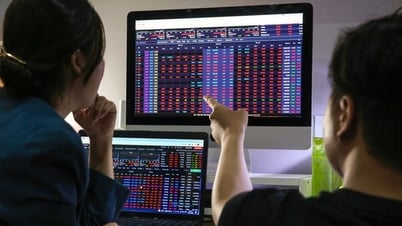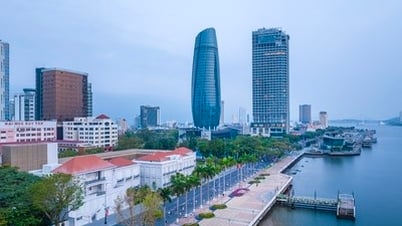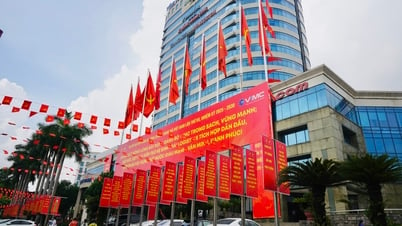On July 2, 2025, US President Donald Trump announced that the US had reached a trade agreement with Vietnam. formation, the US will impose a 20% tax on exports from Vietnam and a 40% tax on transit goods; Meanwhile, Vietnam will cut import taxes on goods from the US to 0%.
In response to this information, the stock market experienced an explosive trading session in terms of liquidity on July 3, with liquidity on the three exchanges reaching VND38,200 billion. Notably, foreign investors had a session of extraordinary net buying with a net buying value of over VND2,278 billion on the HoSE and over VND2,400 billion on the entire market, the highest since the beginning of the year.
No need to worry too much about tariff risks
Assessing the impact of the initial information on the tariff agreement, Mr. Pham Luu Hung - Chief Economist , Director of SSI Research, SSI Securities Corporation said that this is quite positive information compared to previous scenarios. Vietnam is the third country that can negotiate negotiations related to the framework agreement with the US, which shows that Vietnam is currently one of the world's major partners in the field of trade, and this is a good sign.
SSI's chief economist said that although the detailed tax rate has not been announced, the figure of 20% is an acceptable tax rate, and the negotiation process is still ongoing and may last beyond July 9, due to the issue of rules of origin. While the negotiation may be extended, the application of the current 10% tax rate can still be extended for a while longer.
The 20% tax rate has also been mentioned by SSI Research in previous forecasts. In this scenario, with the expected double-digit profit growth rate of listed Vietnamese enterprises in 2025, around 13%, the VN-Index will be equivalent to more than 1,400 points.
Mr. Pham Luu Hung also added that information about tariffs is gradually coming to an end, the market is also gradually focusing on other stories, such as Vietnam's economic growth in 2025 and 2026.
"We see that the main driving force of Vietnam's economy does not come from the outside but from internal factors such as public investment, infrastructure construction, and promoting domestic consumption... Those are the main growth drivers of Vietnam. At the same time, businesses have also calculated strategies for the coming period and focused on more important factors. Therefore, current information will create general positivity and the market will not need to worry too much about tariff risks in the coming time," SSI's chief economist emphasized.
Many other advantages to offset the tax gap
According to KBSV Securities Company, analysis temporarily divides the understanding of tax rate information into two scenarios.
In scenario 1, the 20% tax rate is the cumulative tax rate of all taxes for goods exported from Vietnam to the US. This figure shows a relatively positive tariff scenario because it is significantly lower than the 46% rate announced for Vietnamese goods on April 2 and not much different from the ~10% rate applied to all countries during the tax suspension period.
In Scenario 2, the 20% rate only takes into account the reciprocal tax, comparing the difference with other countries will be more important than how much tax Vietnam will be imposed. Currently, Vietnam is the third country to reach an agreement with the US (after the UK and China). Vietnam's 20% reciprocal tax is still more competitive than the tax applied to China (depending on the product) and is not much different from the current lowest rate in the UK (10%).
KBSV believes that if the US tax rate applied to other countries is not much lower than that of Vietnam (not more than 10%), the negative impact on import-export activities and FDI shift will be reduced because Vietnam has other advantages to compensate such as: Preferential policies to attract FDI; Cheap labor source, Favorable geographical location in the regional supply chain... These factors help Vietnam continue to maintain its attractiveness in the eyes of FDI investors with a real production orientation.
Overall, the market still needs to monitor further until the detailed tax framework is applied to each item and compared with the corresponding competitors. In addition, the 40% tax rate will apply to "transit" goods, but the specific definition of "transit" has not been announced (raw material content or calculated by production stage) - this is the key factor to assess the actual impact, KBSV commented.
Source: https://baodautu.vn/khoi-ngoai-hao-hung-gom-hang-ky-luc-chung-khoan-nhe-noi-lo-au-ve-thue-quan-d321304.html






![[Photo] Prime Minister speaks at the High-level Discussion Session of the Expanded BRICS Summit](https://vphoto.vietnam.vn/thumb/1200x675/vietnam/resource/IMAGE/2025/7/7/70b6e323f350404fa23f60527a4a8794)


























































































![[OCOP REVIEW] Bay Quyen sticky rice cake: A hometown specialty that has reached new heights thanks to its brand reputation](https://vphoto.vietnam.vn/thumb/402x226/vietnam/resource/IMAGE/2025/7/3/1a7e35c028bf46199ee1ec6b3ba0069e)






Comment (0)